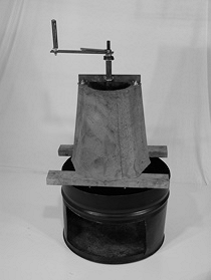
What makes appropriate technology is determined by context. Therefore, none of these are absolute — they are simply common features that make a technology "appropriate" to a world where many suffer a lack of basic necessities, a lack of money, and lack of equipment and technological expertise.
- Small (as in Small is Beautiful) — Small often means affordable and adaptable, and puts the control in the hands of the users. Small also means local, which offers benefits in resilience. This places more power at the grassroots, in the hands of the users. However, there are also times when the most appropriate technologies are large-scale.
- Few moving parts — Less to go wrong (similar to the KISS principle,W and the "durable, efficient, stoic" principle).
- Can be built locally
- Made with locally available materials
- Easily repaired — By local people with locally available equipment.
- Affordable
- Suitably disposable — Locally and not polluting in it's disposal or recycling
Features such as low cost, low usage of fossil fuels and use of locally available resources are advantages in sustainability. For that reason, these technologies are sometimes used and promoted by advocates of sustainability and alternative technology. They are also technologies that have a gentle impact on the environment.
The source of the technology doesn't matter much. It matters much more that it is appropriate. While the source of a technology sometimes becomes an issue in discussions of technology for international development, technology from anywhere can have uptake and make an impact, as evidenced by the mobile phone.
More generally, appropriate technology is appropriate to the context, including the environmental, ethical, cultural, social, political, and economical context. The appropriate technology for one context may not be appropriate for another. Appropriate technology is also sustainable, requiring fewer natural resources and producing less pollution than techniques from mainstream technology, which are often wasteful and environmentally polluting.[1] In addition, or in envisioning a future phase of AT that lies on a more subjectively-observed axis of knowing, proponents could also claim their methods make more life(-energy) sense, are more at balance or in harmony with the natural environment, and enable appropriate, healthier, happier, more fulfilling, meaningful or purposeful ways of life.
In practice[edit | edit source]
Some additional practical considerations are:
- Using parts in the design that are already mass produced and that are globally or widely available reduces the cost a lot. For example, tyres that are already manufactured for automobiles are frequently used as plant pots in permaculture designs,...
- Reducing the amount of material needed is also useful. Dimensioning ie metal parts to only the thickness as required for the structure's rigidity, allows to produce more parts and will thus reduce the cost.
- Design using assimilationW of several similar devices, wherever possible. This could allow you to combine the best of several worlds, hereby improving the design.
The design should also take into account how it will be built. Ie will it be built by people that actually understand how the object they are building works, or do they not fully understand it ? Designing something from scratch (bottom-up approach) is a lot more difficult than just piecing together a set of parts (top-down approach). An example of a top-down approach is what William Kamkwamba W did when building his wind turbine (he used commercial parts). However in practice, it often yields little efficient machines/objects. The only upside (besides being less difficult to do) is that it is also less labour-intensive, and often cheaper (ie parts can be attained from local salvage sites (ie junkyards, municipal waste sites,...) Designing something yourself, and having each part purpose-built ensures that optimal efficiency can be attained (ie in the wind turbine example, the dynamo/alternator would need to be sized according to the bladed rotors).
A method in between both is the use of kits or manuals. Kits are a sort of top-down approach (uses pre-made components), yet as the components are all pre-made specifically for a design (rather than coming from different devices) it still yields a efficient design.
See also[edit | edit source]
References[edit | edit source]
- ↑ Appropriate Technology Sourcebook: Introduction at VillageEarth.org. Accessed on 5 July 2008.